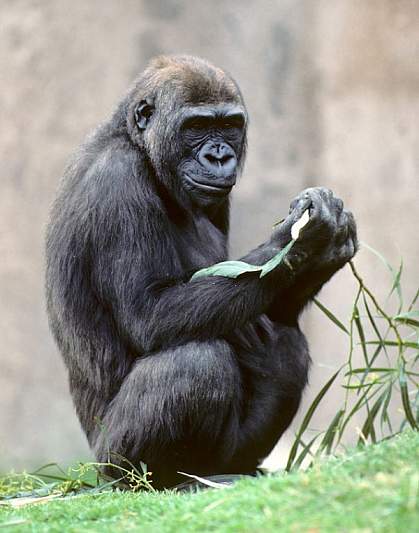You are here
March 19, 2012
Gorilla Genome Yields Surprises

Researchers have completed a draft sequence of the gorilla genome. Their analysis reveals that people may be more closely related to gorillas than we realized.
Comparing the human genome sequence with those of other organisms helps us understand how we evolved and what makes us unique. Such comparisons can also help scientists better understand human genes and gain insights into disease.
The gorilla is our closest living relatives after chimpanzees and the last of the great apes to have its genome sequenced. Gorillas survive today only in isolated, endangered groups in the forests of central Africa. An international team led by researchers at the Wellcome Trust Sanger Institute sequenced the gorilla genome. Their work was funded by the Wellcome Trust, NIH's National Human Genome Research Institute (NHGRI) and others. The results were published in Nature on March 8, 2012.
The team assembled a draft sequence from a single female western lowland gorilla (Gorilla gorilla gorilla) named Kamilah. They compared Kamilah's genome with the human, chimpanzee, orangutan and macaque genomes. The comparison, along with fossil evidence, places the human and chimpanzee species divergence between 5.5 and 7 million years ago. Their common ancestors split from gorillas 8.5 to 12 million years ago.
Chimpanzee sequences are more similar to equivalent human sequences than to gorilla sequences in about 70% of the genome. In about 30% of the genome, however, gorillas are more similar to humans or chimpanzees than the latter are to each other. Analysis of how these sequences sorted as the species diverged gives insight into how the great apes evolved.
Genes that confer an evolutionary advantage change more quickly over time. In gorillas, the researchers found high rates of change in genes for the perception of sound and for ear, hair follicle, gonad and brain development. Among the fastest changing genes is one that affects the hard coating on the knuckle pads that gorillas use for walking.
One curious finding was that the hearing-related genes evolved quickly in both gorillas and humans. Many researchers had thought that the evolution of auditory genes was linked to language, but this result calls that idea into question.
The scientists also collected less extensive sequence data for 2 western lowland gorillas and one eastern lowland gorilla. They found that the gorilla species diverged from each other about half a million years ago.
The team found several genetic variants that have been tied to human disease in all the gorillas for which they had sequence data. Examples include variants linked to dementia and heart disease. Such variants were found in studies of the chimpanzee and macaque genomes as well. Further research will be needed to understand why these variants cause disease in people but not in other primates.
“Our research completes the genetic picture for overall comparisons of the great apes,” says senior author Dr. Richard Durbin of the Wellcome Trust Sanger Institute. “After decades of debate, our genetic interpretations are now consistent with the fossil record and provide a way for palaeontologists and geneticists to work within the same framework. Our data are the last genetic piece we can gather for this puzzle: there are no other living great ape genera to study.”
—by Harrison Wein, Ph.D.
Related Links
- Orangutan Genome Sequenced
- Monkey Genome Gives New Insight Into What Makes Us Human
- Comparative Genomics
References: Nature. 2012 Mar 8;483(7388):169-75. doi: 10.1038/nature10842.
